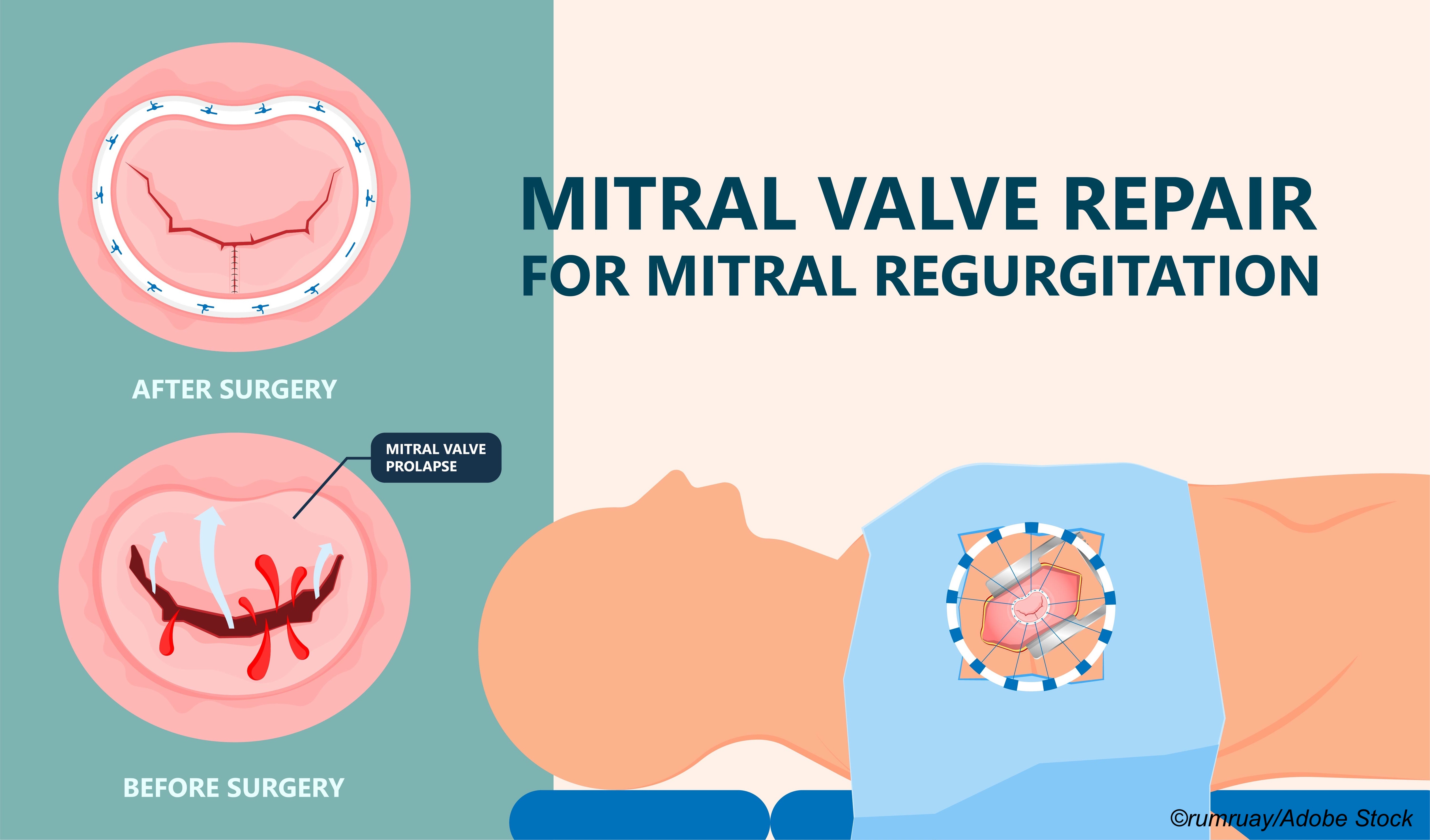In patients with secondary mitral regurgitation (SMR) who underwent mitral valve transcatheter edge-to-edge repair (M-TEER), application of adapted Cardiovascular Outcomes Assessment of the MitraClip Percutaneous Therapy for Heart Failure Patients With Functional Mitral Regurgitation (COAPT) enrollment criteria identified a specific phenotype with lower mortality rates. Stratification with adapted Percutaneous Repair or Medical Treatment for Secondary Mitral Regurgitation (MITRA-FR) criteria, however, was not effective, with comparable outcomes in both eligible and ineligible patients.
Researchers concluded, therefore, that stratifying patients with SMR for M-TEER using adapt COAPT study enrollment criteria may aid in future patient selection, and published their results in the Journal of the American College of Cardiology.
“This is the largest study applying adapted COAPT and the first simultaneously applying MITRA-FR inclusion and exclusion criteria to a real-world M-TEER cohort,” wrote Benedikt Koell, MD, of the University Heart and Vascular Center Hamburg, and the German Center for Cardiovascular Research, Partner Site Hamburg/Lübeck/Kiel, Germany, and colleagues.
For this retrospective analysis, they included 1,022 patients (median age: 74 years) treated with M-TEER from November 2008 to September 2019 enrolled in the European Registry of Transcatheter Repair for Mitral Regurgitation registry, a large, real-world, multicenter registry. Patients were stratified into COAPT-eligible (n=353) and COAPT-ineligible (n=669) groups, as well as MITRA-FR-eligible (n=408) and MITR-FR-ineligible (n=437) groups.
COAPT-eligibility was defined as SMR ≥3+, New York Heart Association (NYHA) functional class ≥II, left ventricular (LV) ejection fraction ≥20% and ≤50%, LV end-systolic diameter ≤70 mm, tricuspid regurgitation <3+, pulmonary artery systolic pressure ≤70 mmHg, and preserved right ventricular function.
MITRA-FR eligibility was defined as an NYHA functional class ≥II, LV ejection fraction ≥15% and ≤40%, regurgitant volume >30 mL/beat, and/or EROA >20 mm2.
After a median follow-up of 2.2 years (maximum: 10.49 years), Koell and colleagues observed that stratification according to adapted MITRA-FR criteria brought about comparable all-cause mortality outcomes (P=0.19), but that stratification of adapted COAPT criteria showed lower mortality rates in patients who were COAPT-eligible than COAPT-ineligible patients (P˂0.001). COAPT-eligible status was associated with improved survival (HR: 0.60; 95% CI: 0.45-0.81; P˂ 0.001).
Upon multivariate Cox regression analysis, these researchers found that independent outcome predictors included:
- NYHA functional class IV (HR: 2.29; 95% CI: 1.53-3.42; P˂ 0.001)
- Logarithmic N-terminal pro-brain natriuretic peptide (HR: 1.47; 95% CI: 1.24-1.75; P˂ 0.001)
- Right ventricular-to-pulmonary arterial coupling (HR: 0.10; 95% CI: 0.02-0.57; P=0.009)
They also found improvements in functional outcomes in a subset of patients regardless of their COAPT eligibility status. For example, there were significant increases in 6-minute walk distances after 6 weeks or latest follow-up for both COAPT-eligible (median change: +14 m; P=0.0047) and COAPT-ineligible patients (median change: +57 m; P˂0.001) and significant reductions in Minnesota Living With Heart Failure Questionnaire (MLHFQ) scores (-19.0 [P˂0.001] and -11.0 [P˂0.001], respectively).
Koell and colleagues warned, however, that these data on functional outcomes were available in a limited number of patients and urged caution in interpreting these results. They also put a special emphasis on differences in baseline characteristics in these patients.
“It is essential to highlight that COAPT-eligible patients had smaller LV dimensions compared with patients in the original trial. MITRA-FR-eligible patients likewise had smaller LV end-diastolic volumes than patients in the original trial (114.1±41.0 mL/m2 among MITRA-FR-eligible patients versus 136.2±37.4 mL/m2 in the original trial),” they wrote.
“Even more crucially, the retrospective application of adapted enrollment criteria conversely resulted in diametrically opposing EROA values (median EROA 0.32±0.20 cm2 among COAPT-eligible patients versus 0.41±0.15 cm2 in the original COAPT trial; 0.41±0.32 cm2 among MITRA-FR-eligible patients vs 0.31±0.10 cm2 in the original MITRA-FR trial),” they added.
“Patients who were ’COAPT-eligible’ had lower 2-year mortality after TEER than those who were ’COAPT-ineligible.’ There was no difference in 2-year mortality between patients who were ’MITRA-FR-eligible’ versus ’MITRA-FR-ineligible.’ These data, despite the inherent limitations of an uncontrolled, retrospective registry, are consistent with the outcomes of the TEER groups of the trials, and they support the emerging consensus that [functional mitral regurgitation] FMR is not a single, homogeneous entity but rather a complex clinical syndrome manifesting in different phenotypes,” wrote Paul A. Grayburn, MD, and Milton Packer, MD, of Baylor Scott and White Heart and Vascular Hospitals, Dallas and Plano, Texas, in their accompanying editorial.
“An expert multidisciplinary heart team and shared decision-making are needed, as therapeutic options include appropriate medical therapy, CRT, coronary revascularization, TEER, mitral valve surgery, advanced heart failure therapies, and hospice care. The question of whether TEER is superior to medical therapy in patients with disproportionate FMR has been answered by COAPT, but the benefit of TEER depends on the FMR phenotype and the response to medical therapy,” they concluded.
Study limitations include limited data, lack of a control group for COAPT-ineligible patients, lack of data on duration of guideline-directed medical therapy or daily dosage, and limited data on functional outcomes. Researchers also noted that they did not use corrected N-terminal pro-brain natriuretic peptide to stratify patients as did researchers of the original COAPT trial.
-
In a real-world cohort of patients with secondary mitral regurgitation who underwent M-TEER, applying adapted COAPT enrollment criteria successfully identified a specific phenotype in whom mortality rates were lower.
-
Stratification according to adapted MITRA-FR study criteria, however, resulted in comparable outcomes.
Liz Meszaros, Deputy Managing Editor, BreakingMED™
Koell reported no disclosures.
Grayburn has received grant support from Abbott Vascular, Cardiovalve, Edwards Lifesciences, W.L. Gore, Medtronic, and NeoChord; and serves on advisory boards for Abbott Vascular, Edwards Lifesciences, W.L. Gore, Medtronic, and 4C Medical.
Packer is a consultant for AbbVie, Actavis, Amgen, Amarin, AstraZeneca, Boehringer Ingelheim, Bristol Myers Squibb, Casana, CSL Behring, Cytokinetics, Eli Lilly & Company, Johnson & Johnson, Eli Lilly & Company, Moderna, Novartis, ParatusRx, Pfizer, Relypsa, Salamandra, Synthetic Biologics, and Theravance.
Cat ID: 308
Topic ID: 74,308,730,308,914,192,925,492




Create Post
Twitter/X Preview
Logout